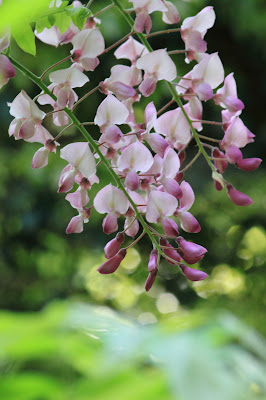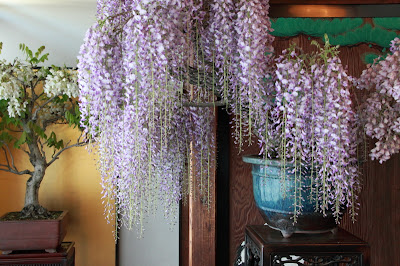This year seemed not to be a good year for wisterias. Nara Park was supposed to become the paradise of wisterias. But, the clusters were shorter and the flowers were less than usual. What happened to them? Last year they did splendid jobs and pleased the eye of people. I guess the wisterias were too tired to bloom in full power and Spring Goddess decided to give them a rest.
Why are wisterias here and there in the park?
In the 8th century when Nara became the new capital of Japan, the Fujiwaras were the most powerful and rich clan. They expanded their political power through marriage with the Imperial family. The same old story here! Fujiwara means "Wisteria Field". Wisterias were the Fujiwaras' favorite flowers.
Kasuga Grand Shrine
Kasuga Grand Shrine was founded by the Fujiwaras as their family shrine as well as the guardian deity for the new capital in the 8the century. The shrine is famous for a seven hundred year old wisteria which is called "Sand-Sweeping Wisteria (砂摺りの藤)" as the clusters grow long and look as touching the ground almost. The longest cluster was measured 1.65 meters in length last year.

This is one of two guardian lions in front of the second Torii gate.
The crest of the Fujiwaras is carved on the pedestal.
The shrine maidens wear a crown of wisteria flowers.
This is "Rice Planting Ceremony" held every year in March in the shrine.
I have ambivalent feelings toward wisterias. The hanging flowers are graceful. The colors of wisterias, various shades of purple, are so noble. But under the flowers there are vines coiling and twining other trees. And they are climbing up and blooming on the top.
This is my blog about wild wisterias.
I love wild wisterias more than cultivated ones, because I can see the nature of the flowers in the wild wistreerias better. This year, the wild wisteria bore less and less flowers. So, no photos of them.
For me snake-like vines of wisterias look like the legacy
of the power struggles fought in the Imperial court in the 8th century.
of the power struggles fought in the Imperial court in the 8th century.
Purple has been a noble and mysterious color since ancient times.
紫草(むらさき)の にほへる妹を 憎くあらば 人妻ゆゑに われ恋ひめやも
大海人皇子
Oh, beautiful you, like a purple grass!
How I can give up my love towards you
even though you are other man's wife!
(mentioned by Prince Oama in the 7th century)
What a passionate love letter it is! Though there is another interpretation, I'd like to take this poem as the outpouring of his emotion. According to one theory, in those days purple was so loved that the color was synonymous with purple. The flowers of purple grasses were mentioned a several times in an ancient anthology of poems which has been loved for over 1200 years by people in Japan. It is 万葉集 - Anthology of Ten Thousand Leaves.
The flowers of purple grasses are lily white. The dried roots of the grasses were used to dye clothes in deep purple and the grass symbolized a lover. I wonder what color it is. They say natural purple is much deeper than synthetic purple.
Flikering like puple stained glasses.
In "The Tale of Genji" (源氏物語) written by Murasaki Shikibu around the beginning of the 11th century, two ladies take important roles in the story. One is 藤壷, Lady Fuji-tsubo and another one is his wife, 紫の上, Murasaki-no-ue. Fuji means wisteria flowers and Murasaki is purple in English. Two women are depicted as his ideal female figures. Shining Genji devotes his eternal love to them. The name of the author also has the color purple.
"The Potted Wisteria Exhibition"held in May in Nara.



















So much beauty. I love this sensibility and tenderness of beauty in thise pictures.. huge travel fever was attack on me when i saw these. Japan is like my second home. it feels so cosy and just like home :)
ReplyDeletehave a nice day, thank you so much for your wonderful blog :)
I love purple and love, love wisteria. Thanks for this nice historical look at wisteria in Nara!
ReplyDeletePerhaps it wasn't a good year for wisteria, but your photos are so beautiful! (Especially the close-ups.)
ReplyDeleteThe Sand-Sweeping Wisteria has clusters that measured 1,65m? That's longer than I am!
The wisteria flowers were disappointing in Tokyo, too, but I could enjoy their beauty in this post. Happy.
Although I can see that the Wisteria isn't as robust and lucious as last year, their delicacy and wispy attititude (which your pictures show beautifully!) this year is most enchanting.
ReplyDeleteThat unusual delicacy makes this year's presentation more appealing than ever. Thanks for a lovely post, Keiko!
砂ずりの藤は過去最長1m65㎝もあったのですね。 私が昨年訪れた時は砂ずりとは程遠く、房も1mにもならず、前年の猛暑と春先の寒さのためと思っていましたが、今年は冬の厳しい寒さのせいでしょうか。 藤の花は一週間と、桜と同じくはかない命です。私の印象では、房が毎年短くなっているように感じます。
ReplyDelete素晴らしい写真の数々、特に2番目,5番目とヘッダーのが大好きです。今年は藤を見に行く機会がなく、こうして堪能させていただき、ありがとうございます。
This was a bad year? I can't wait to see what it looks like in a good year. From the photographs wisteria flowers looks so delicate and beautiful. Where I live I do not see any Wisterias, and as usual I want to jump on the airplane and go visit Nara....
ReplyDeletesnowwhiteさんの藤への視点が好きで、今年もこうしてポストして下さり、楽しんで拝見、拝読しました。春日神社もよく撮っていらっしゃいますが、季節の光線によって感じるものが違ってくるようです。写真の世界も不思議ですね。
ReplyDelete私も春日大社へ藤を初めて見にいきました。あまりに短いので二日後また行きました。そしたらもう枯れはじめていました。又又がっかり。でも、万葉植物園、これも初めていったのですが、こちらは、とてもきれいで、いい香りもただよっていて、楽しめました。
ReplyDeleteほんとにみごとな藤ですね。写真が上手だと一つ一つが絵画のようにみえます。
ReplyDeleteThe Wisterias are so beautiful and enchanting! I love the meaning that they convey through their colour Purple, how mystical! Since the spring goddess has rested them this year around, they will come back full force the next year surely! If this below par bloom sighting is so magical, I can only imagine the landscape when it blooms in abundance... paradise it surely must be!
ReplyDeleteThe wisteria is one of my favorite flowers, when it is in full bloom it reminds me of a waterfall of flowers. I didn't realyze there was a wild variety nor that wisteria could be grown in pots.
ReplyDeleteThank you,
Oh wow - your shots are so beautiful and artistic. I've never really seen how beautiful wisteria can be until now.
ReplyDeleteうねうねと曲がった幹を持つ藤の花が 光と風と共に捕えれていて、ため息がでるほど美しです。実に様々な色があるのですね! 源氏物語を例にお話し頂くと、藤の花が高貴で最も愛された花のたとえになる事がうなずけます。柔らかな新緑と優しい光の中、まるで自分が最も輝く時代に咲く術も知っているようですね。苔むした石を背景に、まだ幼そうな鹿の後ろ姿がとても可愛いです。楽しませて頂きありがとうございます。
ReplyDeleteThank you for this lovely post. I love the picture of the shrine especially. I always think wisteria are so elegant, as if designed to be drawn by artists. I think there are always better and worse years for flowers - perhaps the details of the weather when they were growing or hibernating is the cause of this.
ReplyDeleteKeiko,the wisteria blooms look splendid,one would never know they were not up to usual expectations! The image with gold fish is my favourite,but they're all beautiful.Thanks for sharing the history.
ReplyDeleteWe do have cultivated wisteria here but the flower clusters are smaller,no doubt something to do with our climate.
Enjoy your week!
Ruby
新聞に兵庫県の白毫寺の見事な白藤が載っていたので、春日大社の藤も見事なのだろうなと思っていたのですが。でも写真の中の藤は、この上なく繊細で優雅です。まっすぐに流れる線の美しさはたとえようもないくらい・・・
ReplyDeleteヘッダーも、5月の光が水面に煌めいて、すばらしいですね。いつも魅せられます。
the weeping beauty of wisteria is not to be denied. I love the large, twisted root photo, though all are superb. you capture grace and emotion so beautifully. happy week to you Keiko.
ReplyDeleteGorgeous! I love wisteria too! Ours are not as beautiful as yours, Thank you for sharing their gracefulness!
ReplyDeleteHow pretty the young women look with the flowers in their hair. We have wisteria in my part of the world, too, and it is a much-admired plant. The significance of the color purple is interesting information I was not aware of until now. :)
ReplyDeleteおはようございます。我が家の家紋も下がり藤です。
ReplyDelete「むらさきの ひともとゆえに むさしのは はなはみながら あわれにとぞみる」 この歌にちなんで母校の高校のムラサキを校章に使ってます。
また奈良にゆっくり旅をしたいとの思いに駆られました。
Wonderful photos. Beautiful flowers with delicious colors, I love the delicate light they give off, spring finest in this beautiful place. Greetings.
ReplyDeleteJust thought I’d stop by again to thank you for wishing me well on my new blog. Yours is the first comment and your words are very special. :)
ReplyDelete